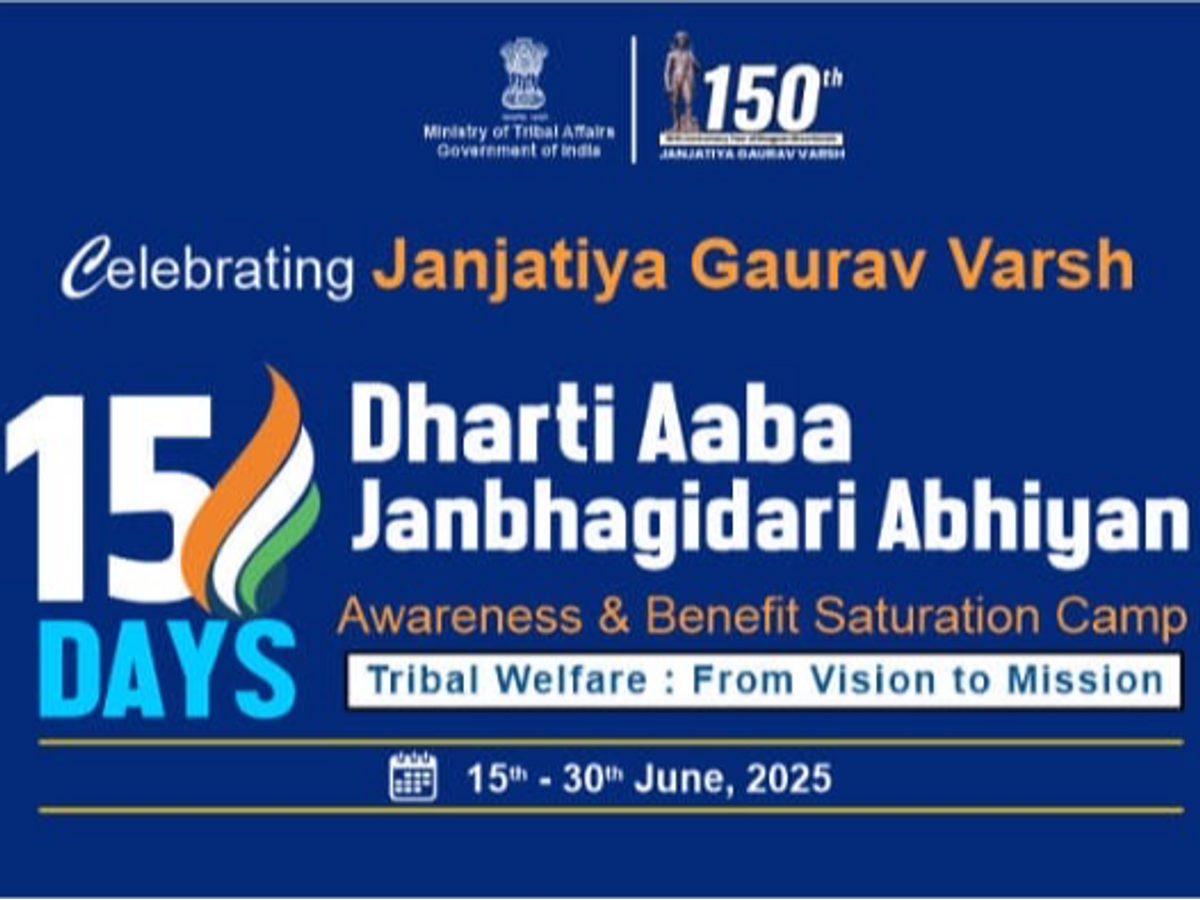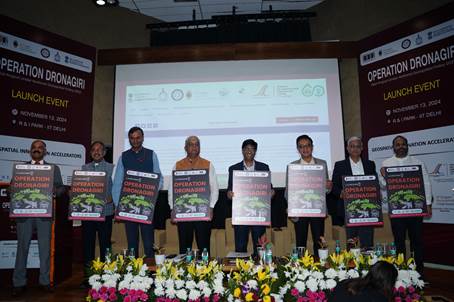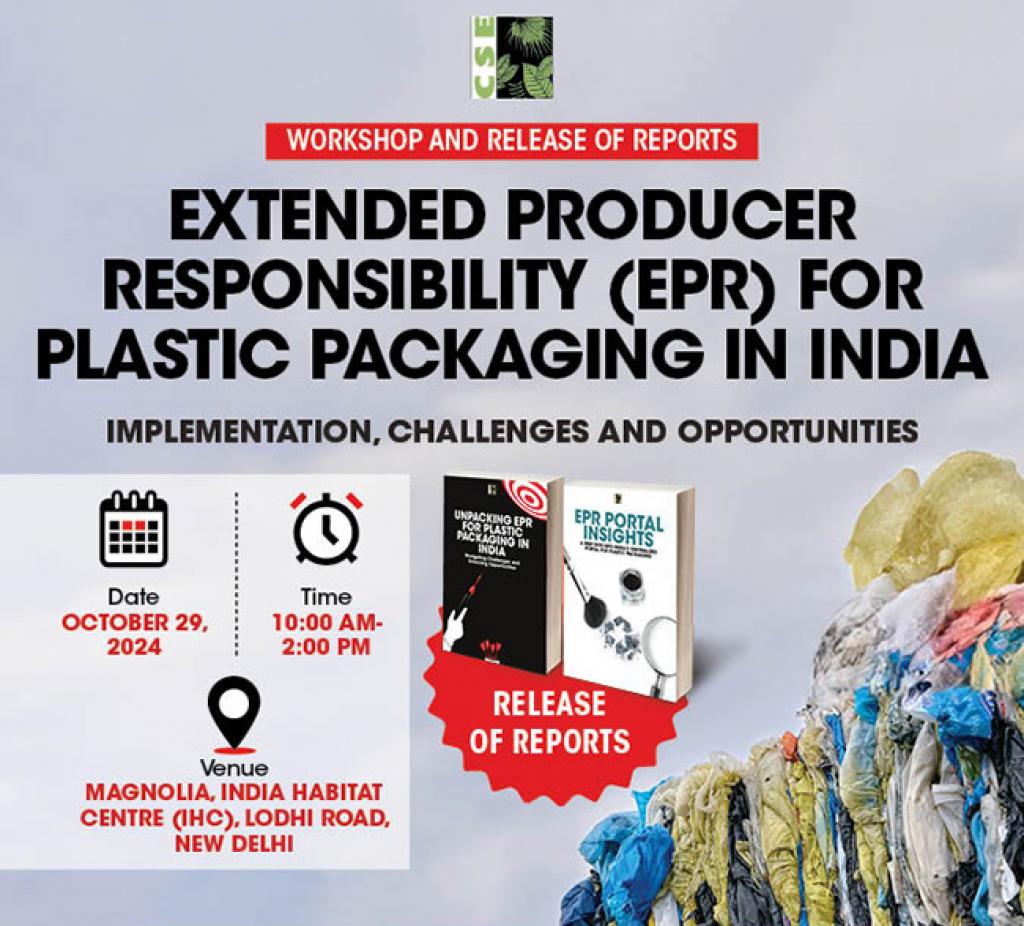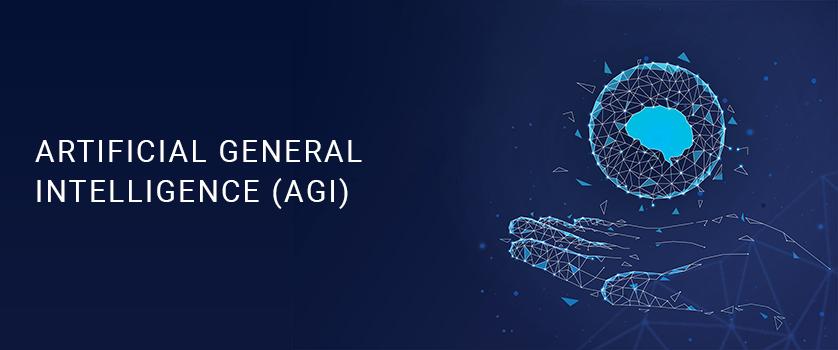Dharti AabaJanbhagidari Abhiyan (DAJA)

- 28 Jun 2025
In News:
In a landmark initiative for tribal inclusion, the Government of India has launched the Dharti AabaJanbhagidari Abhiyan (DAJA)—India’s largest-ever tribal outreach and empowerment campaign. The programme aims to ensure saturation of welfare schemes and promote tribal pride and participation, covering over 1 lakh tribal villages and PVTG habitations across 31 States and Union Territories.
What is DAJA?
- Full Name: Dharti AabaJanbhagidari Abhiyan — named in honour of Bhagwan Birsa Munda, a revered tribal freedom fighter.
- Launched by: Ministry of Tribal Affairs, Government of India.
- Nature: A people-centric campaign focused on participatory governance and last-mile delivery of services among Scheduled Tribes (STs) and Particularly Vulnerable Tribal Groups (PVTGs).
Objectives of DAJA
- Saturate government welfare schemes across all tribal settlements.
- Empower over 5.5 crore tribal citizens through Janbhagidari (people’s participation).
- Preserve and promote tribal identity and cultural heritage, invoking the legacy of Birsa Munda.
- Strengthen last-mile governance through technological and administrative convergence.
Key Features:
Feature Description
Geographic Coverage - 1 lakh+ tribal villages, including remote PVTG habitations, across 31 States/UTs.
Scheme Integration - Converges services such as Aadhaar, Ayushman Bharat, PM Kisan, PM
Ujjwala, Jan Dhan, pension schemes, and Forest Rights Act (FRA) claims.
Five Foundational Pillars -
- Janbhagidari (people’s participation)
- Saturation of welfare benefits
- Cultural inclusion
- Convergence of schemes
- Last-mile delivery
Technology-Driven Monitoring - Use of real-time dashboards and data analytics for
transparent tracking and reporting.
Cultural Revival - Celebrates tribal cuisines, folk arts, handicrafts, and oral traditions
during outreach camps to reaffirm cultural identity.
Significance:
- Governance: Represents a shift toward targeted and integrated tribal welfare, reducing administrative fragmentation.
- Inclusion: PrioritisesPVTGs, often the most marginalised and underserved groups.
- Empowerment: Embeds a participatory model, aligning with the spirit of democratic decentralisation.
- Cultural Reaffirmation: Bridges the gap between development and cultural identity, crucial for tribal dignity and preservation.
UNESCO’s “Imagine a World with More Women in Science” Campaign

- 21 Feb 2025
In News:
On February 11, 2025, to mark the 10th anniversary of the International Day of Women and Girls in Science, UNESCO, with support from Canada’s International Development Centre (IDRC), launched the global campaign titled “Imagine a World with More Women in Science.”
Campaign Highlights
- Objective: Promote gender equality in science and innovation by encouraging the active participation and leadership of women in STEMM (Science, Technology, Engineering, Mathematics, and Medicine).
- Social Media Drive: The campaign uses the hashtag #EveryVoiceInScience to amplify diverse voices and encourage global engagement.
- Focus: Emphasizes the real-world impact of gender disparities in science, including missed innovations, biased artificial intelligence, and inequitable scientific opportunities.
Background
- The UN General Assembly (UNGA) declared February 11 as the International Day of Women and Girls in Science in 2015 to foster female participation in scientific research and innovation globally.
Current Status of Women in Science
Global Trends
- Representation: Women comprise only one-third of the global scientific workforce.
- Leadership Gap: Merely 10% of STEM leadership positions are held by women.
India-Specific Data
- STEMM Enrolment: Women account for 43% of enrolment in STEMM disciplines.
- Women Scientists: Only 18.6% of scientists in India are women.
- R&D Projects: About 25% of R&D projects are led by women researchers.
Challenges Faced by Women in Science
Challenge Description
Restrictive Social Norms Traditional gender roles hinder women’s
scientific pursuits.
Lack of Role Models Few visible female leaders discourage young women from
aspiring to scientific careers.
Workplace Inequality Gender biases, hostile work environments, and lack of inclusive
policies create barriers.
Educational Gaps Gender-biased teaching content and insufficient support systems
limit girls’ access to science education.
Recommended Measures
Dismantle Gender Stereotypes
- Remove gender biases from teaching and learning materials.
- Include contributions of female scientists in textbooks with visuals.
- Promote equitable representation of women in boards, panels, and decision-making bodies.
Enhance Visibility of Women Role Models
- Highlight discoveries by female scientists.
- Increase media and curriculum exposure to successful women in science.
Open Educational Pathways
- Promote inclusive teaching practices and gender-neutral curricula.
- Encourage CSR (Corporate Social Responsibility) initiatives to support girls in science education.
Create Inclusive Work Environments
- Enforce policies for diversity, equity, and inclusion.
- Take strong action against gender-based violence, including sexism and harassment in the workplace.
- Advance women into leadership roles in scientific institutions.
Ratnagiri Buddhist Site

- 19 Jan 2025
In News:
The Archaeological Survey of India (ASI) has resumed excavations at the ancient Buddhist site of Ratnagiri in Odisha’s Jajpur district, unveiling monumental discoveries that underline its rich religious, cultural, and maritime legacy. This renewed effort comes more than 60 years after the site was first excavated between 1958 and 1961.
About Ratnagiri
- Meaning: Ratnagiri translates to “Hill of Jewels.”
- Location: Situated on a hill between the Brahmani and Birupa rivers, northeast of Bhubaneswar.
- Part of the Diamond Triangle: Along with Lalitgiri and Udaygiri, Ratnagiri forms Odisha’s famed “Diamond Triangle” of Buddhist heritage sites.
- Historical Period: Flourished between the 5th and 13th centuries CE, peaking under the Bhauma-Kara dynasty (8th–10th century CE).
- Buddhist School: An important centre for Mahayana and especially Vajrayana (Tantrayana) Buddhism.
- It possibly rivalled Nalanda in prominence as a Buddhist learning centre.
- The monastery complex at Ratnagiri is the only one in India with a curvilinear roof, once housing about 500 monks.
Recent Discoveries by ASI
- Three colossal Buddha heads, each measuring 3–4 feet.
- A massive palm sculpture, 5 feet in size.
- Hundreds of votive stupas, sculptures of Buddhist deities.
- A monolithic elephant statue, 5 feet long and 3.5 feet tall.
- Pottery, inscribed stones, beads, stone pillars, and a brick wall believed to be part of a larger structure.
- Rich ceramic assemblages, which may shed light on the region’s cultural and technological evolution.
These artefacts are estimated to date back to the 8th and 9th centuries CE and are believed to enhance understanding of Buddhism’s evolution in Odisha and its linkages with other cultures.
Buddhism in Odisha & Southeast Asian Links
- Buddhism gained a strong foothold in Odisha after Emperor Ashoka’s conquest of Kalinga (modern-day Odisha) in 261 BCE, a turning point that led him to embrace Buddhism.
- Though Buddha never visited Odisha, the region became instrumental in spreading Buddhism to Southeast Asia, especially during the Bhauma-Kara period.
- The state maintained robust maritime trade and cultural links with regions like Java, Bali, Sumatra, Borneo, Myanmar, and Sri Lanka.
- Baliyatra Festival: A vibrant annual event held in Cuttack, commemorating Odisha’s ancient seafaring ties with Bali and other Southeast Asian regions.
- According to some studies, Chinese monk Hiuen Tsang may have visited Ratnagiri during his travels in India (638–639 CE).
Significance of the Renewed Excavations
- The ASI aims to uncover partially visible structures, complete the site’s mapping, and contextualize the findings within the broader Buddhist history of India and Southeast Asia.
- Researchers hope to discover signs of foreign architectural or cultural influences, further confirming ancient Odisha’s global Buddhist and trade connections.
- The discoveries reaffirm Ratnagiri’s importance as a cornerstone of Buddhist learning and art, potentially on par with other renowned ancient centres like Nalanda and Vikramashila.
Operation Dronagiri

- 15 Nov 2024
In News:
- Recently, the Operation Dronagiri, launched under the National Geospatial Policy 2022 by the Department of Science and Technology (DST).
- Objective: It is a pilot project under India’s National Geospatial Policy 2022 aimed at showcasing the potential of geospatial technologies in sectors such as Agriculture, Livelihoods, and Logistics & Transport to improve quality of life and ease of doing business.
- Implementation:
- The first phase will cover five states: Uttar Pradesh, Haryana, Assam, Andhra Pradesh, and Maharashtra.
- Sectors Targeted: The focus will be on demonstrating the integration of geospatial data to solve real-world challenges in agriculture, transportation, and livelihoods.
National Geospatial Policy 2022
- Context: The National Geospatial Policy 2022 is aimed at liberalizing geospatial data and enabling widespread access and use of geospatial technologies across various sectors of governance, business, and development.
- Goals:
- Development of Geospatial Infrastructure: Promoting the creation of a robust infrastructure to make spatial data more accessible and usable.
- Geospatial Skill Development: Focus on creating a workforce proficient in geospatial technologies.
- Implementation of Standards: Establishing clear standards for geospatial data to ensure consistency and interoperability.
Role of Integrated Geospatial Data Sharing Interface (GDI)
- Launch: Alongside Operation Dronagiri, the Integrated Geospatial Data Sharing Interface (GDI) was also unveiled.
- Purpose: GDI is designed to facilitate seamless data sharing, access, and analysis of geospatial data.
- Key Features:
- Data Exchange: Enables smooth sharing of geospatial data for urban planning, disaster management, and environmental monitoring.
- Privacy and Security: Built with advanced data exchange protocols and privacy-preserving features to ensure secure data sharing.
- Collaboration: It will promote collaboration among stakeholders, including government agencies, industry, and startups, to unlock actionable insights for decision-making.
- Key Features:
Potential Applications of Geospatial Data
- Urban Planning: Assisting cities in designing efficient infrastructure.
- Disaster Management: Providing real-time data for better disaster response.
- Environmental Monitoring: Supporting initiatives for environmental protection and sustainability.
- Agriculture: Precision farming, crop monitoring, and improving supply chains.
- Logistics & Transport: Streamlining transportation networks, reducing traffic, and improving delivery systems.
Grand Challenge for Startups
- Objective: A Grand Challenge was announced as part of the initiative to support startups in developing Proofs of Concept (POCs) targeting specific problems in the focus sectors.
- Role of Startups: The challenge encourages innovation by early-stage and growth-stage startups in geospatial technology, offering mentorship, resources, and access to datasets.
- Geospatial Innovation Accelerators:
- The Geospatial Innovation Accelerators (GIAs) at prestigious institutions like IIT Kanpur, IIT Bombay, IIM Calcutta, and IIT Ropar will support this effort.
- Mentorship and Resources: These accelerators will provide the necessary support for startups to turn their innovations into scalable solutions.
Key Stakeholders and Operational Arms
- Geospatial Innovation Cell (DST): Responsible for overseeing the project’s implementation and execution.
- Navavishkar I-Hub Foundation (IITTNiF): Will manage the operational activities of Operation Dronagiri.
- Partnering Institutions: GIAs at IIT Kanpur, IIT Bombay, IIM Calcutta, and IIT Ropar will be the operational arms.
- Private Sector Involvement: Significant involvement of private sector companies, including startups, is crucial to ensuring the success and scalability of the project.
Impact and Significance
- Socioeconomic Benefits: The integration of geospatial data into agriculture, transport, and logistics will improve efficiency, reduce costs, and boost economic activity in critical sectors.
- Geospatial Innovation: The initiative marks a significant step towards making India a global leader in geospatial technology and positioning the country as a hub for innovative solutions using geospatial data.
- Government Engagement: The project will involve various government departments and corporates in a public-private partnership (PPP) model, similar to the successful implementation of the UPI payment system.
Centre for Science and Environment

- 03 Nov 2024
In News:
Centre for Science and Environment release a report on Extended Producer Responsibility (EPR) for Plastic Packaging
Key Findings:
- EPR Guidelines (2022) were a step towards enforcing the "polluter pays" principle, but the system faces significant issues in its implementation and registration processes.
- Centre for Science and Environment (CSE) report, released on October 29, 2024, highlights gaps in the EPR system for plastic packaging and suggests corrective actions.
EPR Guidelines Overview:
- Issued by: Union Ministry of Environment, Forest and Climate Change (MoEFCC).
- Objective: Hold producers, importers, brand owners (PIBOs), and plastic waste processors (PWPs) responsible for managing plastic packaging waste.
- Key Requirements:
- PIBOs must register on a centralized portal and set targets for collection, recycling, and reuse of plastic packaging.
- Registration involves compliance with targets on end-of-life recycling and recycled content usage.
Problems Identified in the Current EPR System:
- Low Registration and Enrollment:
- 41,577 registrations on the EPR portal, but a significant discrepancy in the type of stakeholders registered.
- 83% of registered entities are importers, 11% are producers, and only 6% are brand owners.
- Producers contribute 65% of the plastic packaging in the market but have low registration.
- Absence of Key Polluters:
- Manufacturers of virgin plastics are notably absent from the portal, despite being required to register.
- Fraudulent Practices:
- 700,000 fake certificates were generated by plastic recyclers, far exceeding the actual certificate generation capacity.
- The Central Pollution Control Board (CPCB) found that such fraudulent activities are undermining the integrity of the system.
- For example, end-of-life co-processing units (e.g., cement plants) claimed to have processed 335.4 million tonnes per annum of plastic waste, while their actual capacity is just 11.4 million tonnes per annum.
- Underreporting and Mismanagement:
- Despite 23.9 million tonnes of plastic packaging being introduced into the market, the CPCB’s estimation of plastic waste generation (4.1 MT annually) is underestimated.
- Lack of Stakeholder Representation:
- Urban local bodies and informal waste collectors—key contributors to plastic waste management—are not included in the EPR framework, which limits their incentives and support.
Recommendations for Improvement:
- Incorporate the Informal Sector:
- Recognize informal waste collectors and waste management agencies in the EPR framework to improve traceability and ensure better waste management.
- Eliminate Fraudulent Practices:
- Strict actions need to be taken against fraudulent recyclers and fake certificate issuers to restore credibility to the EPR system.
- Establish Fair Pricing for EPR Certificates:
- Undertake baseline cost studies to determine the true costs of plastic waste management, ensuring fair pricing for recycling certificates and preventing undervaluation.
- Standardize Packaging:
- Focus on product standardization to ensure that packaging materials are uniform and easily recyclable.
- Strengthen Monitoring:
- Improve oversight on the registration process and ensure that all polluters (producers, importers, brand owners) comply with the system’s guidelines.
EPR and Plastic Waste Management: Context and Importance
- Extended Producer Responsibility (EPR) is a policy approach where the responsibility of managing the entire lifecycle of plastic products (from production to disposal) lies with the producer.
- It is an essential part of India’s Plastic Waste Management Rules (2016), which mandate the recycling and proper disposal of plastic packaging waste.
Key Elements of EPR:
- Producer Accountability: Producers are responsible for the take-back, recycling, and final disposal of plastic packaging.
- Waste Minimization: Encourages reducing waste at the source by promoting sustainable packaging designs.
- Lifecycle Approach: Considers the entire lifecycle of the product, focusing on sustainability from production to disposal.
- Polluter Pays Principle: Ensures that the cost of waste management is borne by those responsible for generating the waste.
Artificial General Intelligence (AGI)

- 04 May 2024
Why is it in the News?
“GPT-4 is the dumbest model any of you will ever have to use again,” said the OpenAI’s CEO Sam Altman at a time when his company is going big on superintelligence or Artificial General Intelligence (AGI).
What Is Artificial General Intelligence (AGI)?
- Artificial general intelligence (AGI) is a team used to define the concept of development of AI to a level that can almost be capable of human intelligence and able to solve complex problems.
- Artificial intelligence (AI) is a broad field that encompasses various domains and applications, such as computer vision, natural language processing, machine learning, robotics, and more.
- AGI is a fictional Super Intelligence system that can match human intelligence.
- In Normal terms, AGI is also called strong AI, full AI, or general intelligent action.
- AGI systems are expected to have human-like or superhuman cognitive abilities, such as reasoning, planning, learning, communication, creativity, and problem-solving.
- AGI systems would be able to perform any task that humans can do, and even tasks that humans cannot do.
What is the Difference Between AI & AGI?
- AI systems are trained to perform specific tasks that require some level of intelligence, such as recognizing faces, translating languages, playing games, or diagnosing diseases.
- However, these systems are not able to generalize their skills and knowledge to other domains or tasks that they were not trained for.
- This is where artificial general intelligence (AGI) comes in.
- Artificial intelligence is an Umbrella containing the science of developing systems and processes that can replicate human intelligence.
- It's an umbrella containing multiple subdomains specifically built to develop such intelligence systems.
- Artificial General Intelligence is more like the system's ability to learn by itself, and behave like human intelligence. It's an evolved system with the help of heavily trained AI over time.
How can AGI Help Humanity?
- In theory, AGI has innumerable positive implications.
- For instance, in healthcare, it can redefine diagnostics, treatment planning, and personalised medicine by integrating and analysing vast datasets, far beyond the capabilities of humans.
- In finance and business, AGI could automate various processes and enhance overall decision-making, offering real-time analytics and market predictions with accuracy.
- When it comes to education, AGI could transform adaptive learning systems that work towards the unique needs of students.
- This could potentially democratise access to personalised education worldwide.
Marburg virus disease (MVD)

- 24 Apr 2024
Why is it in the News?
The Kitum cave in Mount Elgon National Park, Kenya, is known as the world's deadliest cave which may have some really dangerous viruses inside, like Ebola and Marburg.
What is Marburg Virus Disease (MVD)?
- Marburg virus disease (MVD), formerly known as Marburg hemorrhagic fever, is a severe, often fatal illness in humans.
- It affects both people and non-human primates.
- Marburg and Ebola viruses are both members of the Filoviridae family (filovirus).
- Though caused by different viruses, the two diseases are clinically similar.
- Both diseases are rare and can cause outbreaks with high fatality rates.
- The average MVD case fatality rate is around 50%.
- Rousettus aegyptiacus, fruit bats of the Pteropodidae family, are considered to be natural hosts of the Marburg virus.
Transmission:
- Human infection with MVD typically occurs after prolonged exposure to Rousettus bats inhabiting mines or caves.
- The virus can then spread through human-to-human transmission via direct contact with infected bodily fluids, contaminated materials, or broken skin and mucous membranes.
Symptoms:
- After an incubation period of 2-21 days, symptoms arise abruptly, including fever, chills, headache, and muscle pain.
- A maculopapular rash may appear around day five, most visible on the chest, back, and stomach.
- Other symptoms, such as nausea, vomiting, chest pain, sore throat, abdominal pain, and diarrhea, can manifest, with severity increasing to potentially include jaundice, organ dysfunction, severe weight loss, delirium, and massive hemorrhaging.
- The average MVD case fatality rate is around 50%, varying between 24% and 88% in past outbreaks.
Treatment:
- There is currently no specific treatment for MVD, but early supportive care involving rehydration and symptom management improves survival rates.
Viral Hemorrhagic Fevers (VHFs):
- Viral Hemorrhagic Fever (VHFs) is a group of diseases caused by several distinct families of viruses that affect multiple organ systems in the body.
- These illnesses range from mild to severe and life-threatening, with many having no known cure or vaccine.
- VHFs negatively impact the cardiovascular system and reduce overall bodily function.
Supreme Court’s ban on Patanjali ads

- 04 Mar 2024
Why is it in the News?
Recently, the Supreme Court restrained Patanjali Ayurved from discrediting allopathy in its campaigns, and from advertising products that claim to cure chronic conditions.
What is the Magic Remedies Act?
- The Drugs and Magic Remedies (Objectionable Advertisements) Act of 1954 is a legislative framework to control the advertisement of drugs and prohibit claims of magical qualities in remedies.
- The Act encompasses various forms of advertisements, including written, oral, and visual mediums.
What does the Magic Remedies Act entail?
- Under the Act, “drug” refers to medicines intended for human or animal use, substances for diagnosis or treatment of diseases, and articles affecting the body’s functions.
- Other than articles meant for consumption, the definition of “magic remedy” under this Act also extends to talismans, mantras, and charms that allegedly possess miraculous healing powers or influence bodily functions.
Regulations on advertisements under the Magic Remedies Act:
- The Act imposes strict regulations on the publication of advertisements related to drugs.
- It prohibits advertisements that give false impressions, make false claims, or are otherwise misleading.
- The term “advertisement,” under the Act, extends to all notices, labels, wrappers, and oral announcements.
- Violations of these provisions can result in penalties upon conviction, including imprisonment or fines.
Punishment:
- Violating the Act can result in imprisonment, fines, or both.
- If this is the first conviction for the violator, they may face up to six months in prison, fines, or both.
- For a subsequent conviction, imprisonment may extend to one year, a fine, or both.
- The Act does not include any limits for the fines that may be imposed on individuals or organizations.
Who comes under the Magic Remedies Act?
- The Act applies to all individuals and entities involved in the publication of advertisements, including manufacturers, distributors, and advertisers.
- The Act can hold both individuals and companies accountable for contraventions.
TALAGIRISVARA TEMPLE (The Hindu)
- 29 Oct 2023
What is the News ?
The ancient Pallava period paintings at Talagirishwara temple in Panamalai, Villupuram district, have suffered greatly due to neglect. The painting that showed Lord Shiva's dance has nearly disappeared, leaving only the face of goddess Parvathi and a few small sections remaining.
Facts About:
Talagirishwara Temple is situated in Panamalai village, Viluppuram district, Tamil Nadu, India.
- It is built on a small hill overlooking Panamalai Lake.
The temple was constructed by Pallava king Narasimhavarman II, also known as Rajasimha, during the Seventh Century.
Notable features of the temple include a Vimana similar to the one at Kailasanatha temple in Kanchipuram.
- The Vimana has three layers, with the highest tier being reconstructed.
Inside the temple's garbhagriha, there's a Dharalingam, and a Somaskanda section on the rear wall.
The temple has an Ardhamandapam (partial Mandapam) with walls featuring depictions of divinities like Brahma with Saraswati and Vishnu with Lakshmi.
- It faces east and is surrounded on three sides by sub-shrines.
- Additional sub-shrines and a large Mandapam called Mahamandapam were added at a later date.
The typical Pallava-style pillars with crouching lions can be found in the temple.
The temple houses paintings that resemble those in Ajantha and Chithannavasal.
- These paintings are on the walls of a sub-temple on the northern side of Talagirishwara (Shiva) temple.
- Notable among the paintings is one of Lord Shiva with eight hands dancing, known as Latathilagabhani, watched by Goddess Parvathi.
These paintings are older than the ones in Chithannavasal and were created by covering the stonewalls with a paste made of limestone and sand.
INS Vindhyagiri' (PIB)
- 18 Aug 2023
What is the News ?
President Droupadi Murmu launched the 'INS Vindhyagiri' in Kolkata at Garden Reach Shipbuilders and Engineers Limited (GRSE).
Facts About:
- Project 17A – Vindhyagiri, named after the mountain range in Karnataka, is the sixth ship of the Project 17A program, as per PTI reports.
- Vindhyagiri, a technologically advanced Frigate, and a tribute to the erstwhile INS Vindhyagiri, the Leander Class ASW Frigate.
- Old Vindhyagiri – It is nearly 31 years of service from July 1981 to June 2012, had witnessed various challenging operations and multinational exercises.
- Under the Project 17A program, a total of 4 ships by Mazagon Dock Ltd (MDL) and 3 ships by GRSE are under construction.
- The project's first 5 ships have been launched by the MDL and GRSE between 2019 and 2022.
- Project 17A ships have been designed in-house by the Indian Navy's Warship Design Bureau, the pioneer organization for all warship design activities.
- A substantial 75% of the orders for equipment and systems of Project 17A ships are from indigenous firms.
Source: https://pib.gov.in/PressReleaseIframePage.aspx?PRID=1949974
